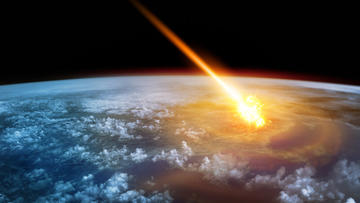New research published today in Proceedings of the Royal Society B reveals how catastrophes – at a planetary, solar system, or galaxy-wide scale – may accelerate transitions from simpler to more complex lifeforms.
The research adds to our understanding of why complex life might be rare in the observable Universe.
The evolution of life has proceeded through a number of key transitions from a primordial soup, to trilobites and dinosaurs, to apes musing about science. But evolution plays out on the stage of physics. In particular the physics of our star, the Sun.

Catastrophes - like the impact of celestial objects with a planet - can 'reset' evolution to earlier stages
Is it common for life to emerge late in the lifetime of its star? Or is it that the complexity of life rarely manages to reach intelligent observers before the star engulfs the habitable planet? Throw into this mix catastrophes such as mass extinctions. These can ‘set back’ evolution to an early state. How do catastrophes complicate the evolution of complex life?
To try and resolve these questions, DPhil student Andrew Snyder-Beattie and Professor Michael Bonsall built some mathematical models that describe evolutionary transitions as ‘states’. They also included the probability of moving from state to another.
They accounted for the life of the star by using mathematical tools called conditional probabilities. The likelihood of one transition depends on the likelihood of another, with an assumption that the planet (e.g. Earth) will exist for a finite amount of time. They used these mathematical tools to describe a move from one evolutionary state to the next.
Their models were able to show the different spread of probabilities for each state (probability distribution). By introducing catastrophes that move the model to an earlier state, they could then predict what the new probability distributions of future transitions would look like.
They found that if complex life is to emerge within the life-time of a star while the biosphere also experiences catastrophes, then evolutionary transitions should accelerate towards the present.
“We shouldn’t necessarily expect to see regularly spaced transitions through evolutionary history. Evolution is in a race against physics and itself. It races not only against the finite lifetime of the planet; it is also against the possibility of being undone by a catastrophe. The faster catastrophes occur, the faster evolutionary transitions must occur to avoid this fate”
Professor Michael Bonsall
The increasing rate of evolutionary transitions may explain why most of Earth’s biological complexity has emerged in the past 500 million years, a relatively short geological timespan. We’ve seen mass radiation of body plans, evolution of land plants, emergence of vertebrates, and the evolution of bigger brains, language and consciousness. Rather than equally spaced evolutionary events, increasing vulnerability of biodiversity to catastrophes will lead to final transitions occurring at an accelerated pace, with each critical step occurring more rapidly than the previous one.
“This means one of the best bets is that life is rare in the cosmos, and other planets are rather inhospitable. So, wouldn’t we be better off paying more attention to preserving our current home for the foreseeable future…?”
Professor Michael Bonsall
To read more about this research, published in Proceedings of the Royal Society B, please visit: https://royalsocietypublishing.org/doi/10.1098/rspb.2021.2711